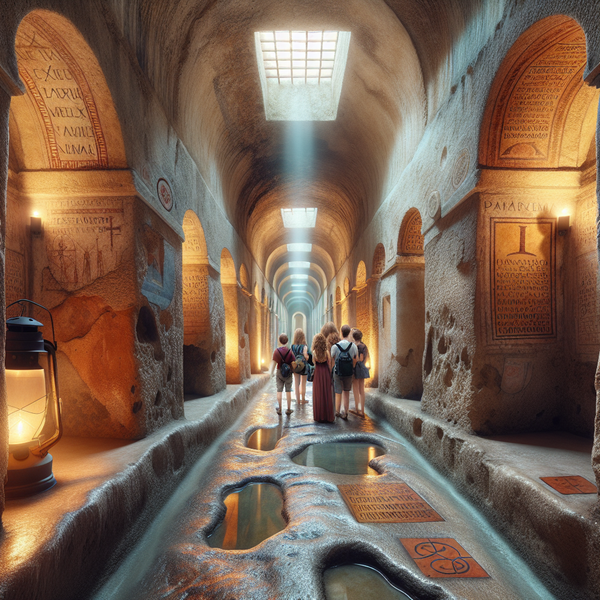When most travelers think of Rome, their minds immediately go to the Colosseum, the Vatican, or the bustling piazzas filled with fountains and cafés. But beneath the Eternal City lies another world—mysterious, sacred, and rich with history. The catacombs of Rome are underground cemeteries that whisper stories of ancient traditions, early Christian devotion, and remarkable engineering. Visiting Rome’s catacombs is not only an unforgettable experience but also a journey that connects you to the roots of European history.
Go to the section
ToggleWhat are Rome’s Catacombs?
The catacombs of Rome are extensive subterranean burial sites carved deep into layers of soft volcanic rock known as tuff. These underground networks were used for funerary purposes, primarily by early Christians, but also by Jewish and pagan communities. Far from being simply grim passageways, the catacombs reveal art, symbols, and inscriptions that hold meaning even today.
Historical Background of the Catacombs
Visiting Rome’s catacombs offers a fascinating insight into a time when communities needed safe and sacred spaces to bury their dead. These underground galleries often stretched for kilometers, creating labyrinths beneath Rome’s soil. Early Christian communities, in particular, used the catacombs not only for burials but also as places for worship during times of difficulty.
Architectural and Artistic Features of the Catacombs
The design of Rome’s catacombs is both functional and symbolic. Narrow corridors contain niches where bodies were laid to rest, while larger chambers served family or communal purposes. Many of these walls are adorned with frescoes, stucco work, and carvings. Images such as the fish, the anchor, and the Good Shepherd hold profound spiritual meaning in early Christian iconography.
Why Were the Catacombs Built in Rome?
The soft rock beneath Rome made it possible to carve long-lasting tunnels, perfect for underground burial grounds. Above ground, land was limited and expensive, which made these underground chambers both practical and spiritual. The catacombs became sanctuaries that balanced necessity with meaning, allowing communities to practice their customs away from public eyes.
Highlights of Visiting Rome’s Catacombs
Visiting Rome’s catacombs is not only about descending into dark tunnels, it is also about understanding the cultural treasures held within. Highlights include frescoes depicting biblical stories, elaborate mosaics, underground chapels, and inscriptions that preserve the voices of ancient inhabitants. The mix of archaeology, spirituality, and history makes the catacombs a true hidden gem of Rome.
Guided Tours of the Catacombs
Because of their complexity, visiting Rome’s catacombs is best done through guided tours. Knowledgeable guides explain the profound symbolism carved into the walls and the stories behind sacred imagery. Tours often combine historical storytelling with practical navigation, ensuring that visitors can explore safely and meaningfully.
Practical Information for Visitors
Visiting Rome’s catacombs requires some preparation. Not all catacombs are open every day, and some have specific entrance restrictions. Comfortable shoes, modest clothing, and respect for the sacredness of the space are essential. Since the catacombs are underground, temperatures remain cool, making it a refreshing stop even during the heat of summer.
Tips to Enhance Your Visit
- Book tickets in advance to avoid long waits.
- Bring a light sweater since underground areas are cooler.
- Listen to guides carefully to unlock the symbolic meanings of catacomb art.
The Symbolism Found in the Catacombs
One of the most captivating aspects of visiting Rome’s catacombs lies in decoding the ancient symbolism. Symbols like the fish and anchor are not random—they were discreet messages of faith and hope. Frescoes depicting biblical figures offered comfort to communities and served to pass down traditions in challenging times.
Notable Catacombs You Can Visit in Rome
There are numerous catacombs scattered across Rome, each with its own distinct features. Some are known for their breathtaking frescoes, others for their vast scale, and some for their historical connections to notable figures. Exploring more than one site allows you to see how these subterranean spaces evolved over the centuries.
- Catacombs famous for rich frescoes and Christian art.
- Catacombs connected with significant early Christian martyrs.
- Jewish catacombs showcasing inscriptions in Hebrew and Greek.
Catacombs as an Archaeological Treasure
For archaeologists and historians, visiting Rome’s catacombs is like opening a time capsule. They provide clues about burial customs, early Christian rituals, and the coexistence of different cultural groups. Each excavation continues to reveal new insights, proving that the catacombs are not just for tourists but also central to ongoing research.
Why Visiting Rome’s Catacombs Should Be on Your Itinerary
Exploring Rome’s catacombs means experiencing the Eternal City from a completely different perspective. While the streets above celebrate grandeur and glory, the catacombs below remind us of everyday lives, quiet devotion, and ancient resilience. Including them in your travel plans offers a deeper understanding of Rome’s layered history.
Final Thoughts on Visiting Rome’s Catacombs
Visiting Rome’s catacombs is more than just a tourist activity—it is an immersive journey underground that enriches your appreciation of history, art, and culture. Whether you are fascinated by archaeology, moved by spirituality, or simply eager to explore beyond the obvious attractions, the catacombs offer something unique. They remain one of Rome’s most intriguing treasures, waiting to be discovered by curious travelers.



